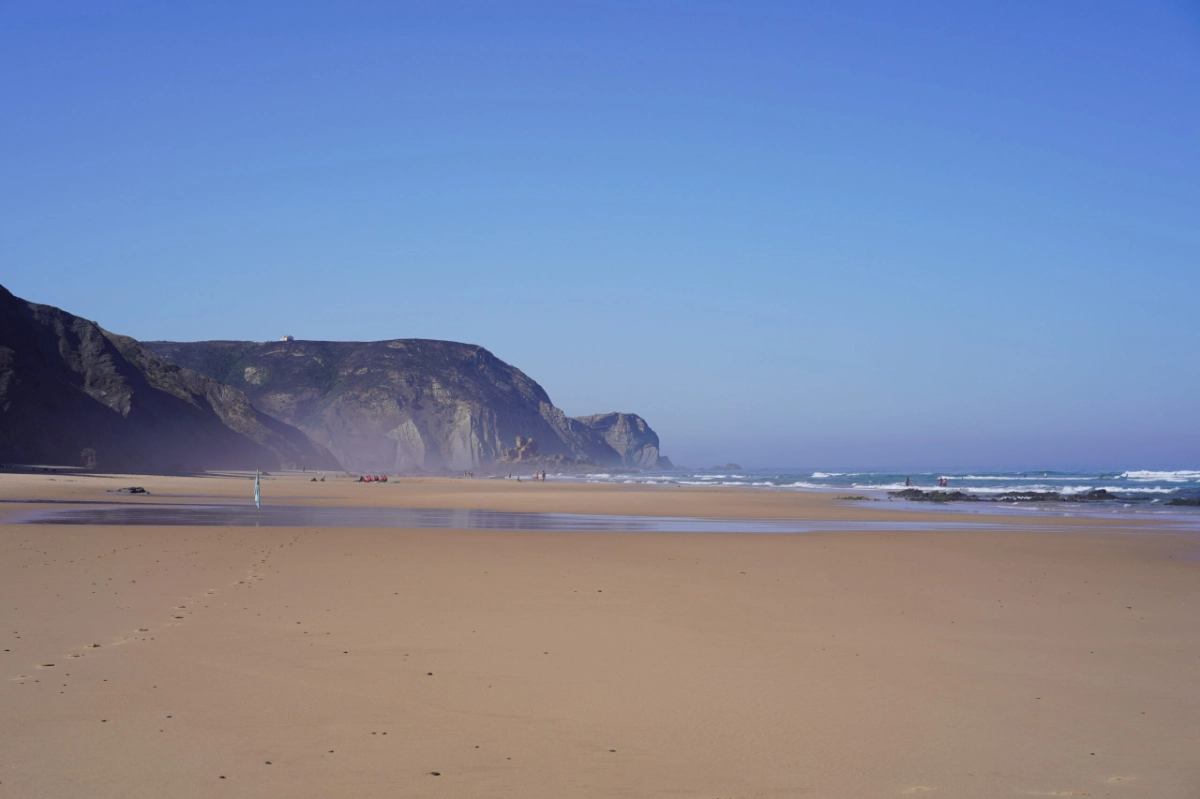Surfing the Algarve: waves, rocks & Portuguese magic
The Atlantic crashes against the rugged southwestern coast of Portugal, carving a landscape that seems purpose-built for surfers. The Algarve isn't just a destination - it's a living, breathing surf ecosystem where ancient rocks, powerful waves, and maritime traditions dance together in a mesmerizing rhythm.With Arenosa Surf camp we'll visit any of these beaches where circumstances are the best for that particular time and tide. But - just for you - this blog will tell you a little more about our most favorite spots here:

Tonel beach: where beginners find their sea legs
Picture a beach nestled beneath historic fortress walls, where waves roll in with a gentle invitation to new surfers. Tonel Beach in Sagres offers exactly this - a natural amphitheater of surf where rocky outcrops create protected zones perfect for learning. The volcanic rocks here aren't obstacles; they're wave sculptors, softening the ocean's intensity and creating perfectly formed breaks for those just starting their surfing journey.During autumn and spring, Tonel transforms into a surf classroom. The water temperatures hover between 16-20 degrees Celsius, warm enough to be comfortable but challenging enough to demand respect. Local surf schools gather here, their instructors reading the ocean's mood like an ancient text, understanding how each rocky protrusion changes the wave's personality.

Praia de Mós: the hidden gem of lagos
Between the bustling town of Lagos and the wild western coast, Praia de Mós emerges as a surf spot that feels like a well-kept secret. Nestled beneath towering limestone cliffs that glow golden in the late afternoon sun, this beach offers a unique surfing experience that captures the essence of the Algarve's coastal magic. What makes Praia de Mós particularly special is its versatility. On calmer days, longboarders find their paradise here, gliding across smooth, rolling waves that seem to emerge from between the rocky formations. When the Atlantic decides to flex its muscles, the same beach transforms into a playground for shortboard enthusiasts, with more aggressive breaks that demand skill and respect.

Cordoama: the wild child of Algarve surfing
If Tonel is a gentle introduction, Cordoama is where the ocean shows its true power. Surrounded by dramatic slate-gray cliffs that seem to have been carved by titan sculptors, this beach demands skill and courage. Advanced surfers are drawn here by waves that rise and fall with dramatic intensity, shaped by underwater rock formations that create unpredictable, thrilling breaks.The landscape here tells a geological story millions of years in the making. Massive boulders line the beach, their surfaces weathered by countless storms, serving as natural wave breakers. Each rock tells a story - of volcanic eruptions, of glacial movements, of the endless conversation between land and sea.

Salema: where tradition meets wave riding
Not every great surf spot needs to be wild and challenging. Salema represents the gentler side of Algarve surfing - a charming fishing village where smooth rocks mix with sandy stretches, creating a more forgiving environment. Here, surfing coexists with traditional Portuguese coastal life, with colorful fishing boats resting near surfers catching mellow waves.

Arrifana: a surfer's crescent of perfection
Arrifana Beach curves like a perfect smile, a natural harbor formed by rocky headlands that create one of the most consistent right-hand point breaks in Portugal. Here, the rocks aren't just landscape - they're wave architects. Experienced surfers find a dance partner in these waters, a place where skill meets natural design.The point break at Arrifana offers something special: waves that peel perfectly along the rocky coastline, providing rides that can stretch for hundreds of meters. During the right conditions, it's like the ocean is offering a personal invitation to surf perfection.
The rocks: nature’s secret surf instructors
Understanding the Algarve’s rocky coastline is key to mastering its waves. These aren’t just obstacles – they’re wave sculptors, tide managers, break creators. Volcanic and sedimentary rocks shaped over millions of years create wave conditions that change with every tide, every season.
Watch how waves interact with rock formations. Learn to read subtle water movements. Understand that these rocks are living, changing entities that communicate through waves.
Best times for surfing
While the Algarve offers year-round surfing, the prime seasons vary:
- Autumn (September-November): Most consistent conditions
- Winter (December-February): Biggest waves for experienced surfers
- Spring (March-May): Mild conditions, fewer crowds
- Summer (June-August): Smaller waves, most touristy period
Essential gear
Bring a 3/2 or 4/3 wetsuit, depending on the season. The water temperatures range from 14-20 degrees Celsius. Pack surf wax, sunscreen, and an adventurous spirit.
More than just waves
Surfing in the Algarve is a holistic experience. It’s about connecting with a landscape that has witnessed centuries of maritime history. It’s about understanding how rocks, water, and human skill create something magical.
Each wave is a story. Each rock is a narrator. And the Algarve? It’s the most incredible book of surf adventures you’ll ever read.
Hang loose, stay stoked, and may your waves be as wild as the Portuguese coast.
